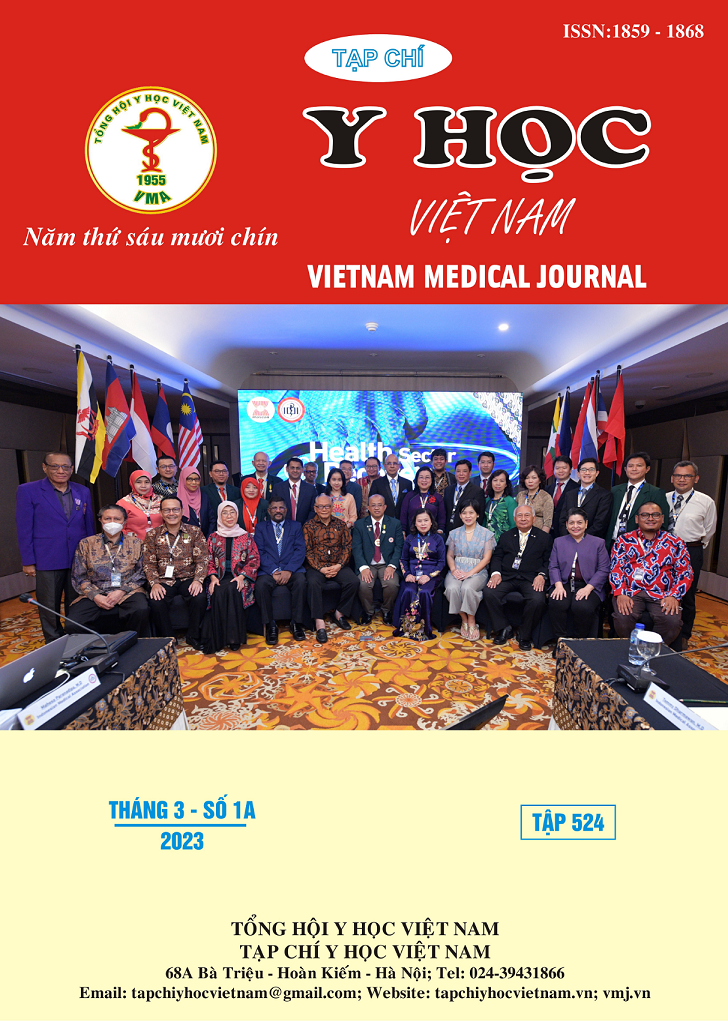A REVIEW OF TREATMENT RESULTS USING VMAT TECHNIQUE FOR RECURRENT MIDDLE-LOWER ESOPHAGEAL CANCER PATIENTS AT VIET NAM NATIONAL CANCER HOSPITAL
Main Article Content
Abstract
Background: Re-irradiation (re-RT) has the active effect of relieving clinical symptoms and prolonging the survival of patients with recurrent esophageal squamous cell carcinoma (ESCC). However, the optimal re-RT dose is still uncertain. Here, we analyzed the prognostic factors associated with survival and explored the re-RT dose for patients with recurrent ESCC following definitive chemoradiotherapy. Patients and methods: The data of 30 patients with recurrent ESCC who were retreated between 2018 and 2021 were analyzed. All patients received a radiation dose > 45 Gy. The median time to recurrence after primary radiotherapy was over 16 months (76.67%). All patients had in-field recurrence in the esophagus. Recurrence within the local and recurrence in both the local site and regional nodes). All patients received VMAT re-RT with a median dose of 45 Gy-50.4 Gy. Chemotherapy was sequentially and survival curves were constructed according to the Kaplan-Meier method and were compared by log-rank tests. Results: Dysphagia relief after re-RT was achieved in 23 patients rates 76.7%. The median survival time (MST) of all patients was 19,85 ± 0,59 months. Severe complications were observed in 0 patients. Conclusion: Our results demonstrated that patients with recurrent ESCC following definitive radiotherapy had unfavorable OS. Re-RT could be considered a feasible and effective treatment modality. A re-RT dose > 45 Gy could improve the survival outcomes, and a dose > 50.4 Gy should be administered with caution due to the risk of severe complications.
Article Details
Keywords
Esophageal squamous cell carcinoma, Local recurrence, Prognostic factors, Re-irradiation dose
References
2. Pennathur A, Gibson MK, Jobe BA, Luketich JD. Oesophageal carcinoma. Lancet. 2013; 381(9864):400–12. 10.1016/S0140-6736 (12)60643-6].
3. Markar SR, Karthikesalingam A, Penna M, Low DE. Assessment of short-term clinical outcomes following salvage esophagectomy for the treatment of esophageal malignancy: systematic review and pooled analysis. Ann Surg Oncol. 2014;21(3):922–31. 10.1245/s10434-013-3364-0]. .
4. Nguyễn Đức Lợi (2015), Đánh giá hiệu quả phác đồ hóa xạ trị đồng thời và một số yếu tố tiên lượng ung thư biểu mô thực quản giai đoạn III-IV tại Bệnh viện K., Luận án tiến sỹ y học, Đại học Y Hà Nội. .
5. Lordick F., Mariette C., Haustermans K. et al (2016). Oesophageal cancer: ESMO Clinical Practice Guidelines for diagnosis, treatment and follow-up. Ann Oncol, 27(suppl_5), v50–v57. .
6. Napier K.J., Scheerer M., và Misra S. (2014). Esophageal cancer: A Review of epidemiology, pathogenesis, staging workup and treatment modalities. World J Gastrointest Oncol, 6(5), 112–120.
7. Pennathur A., Gibson M.K., Jobe B.A. và cộng sự. (2013). Oesophageal carcinoma. The Lancet, 381(9864), 400–412.
8. Liang Hong (2018). Survival benefit of re-irradiation in esophageal Cancer patients with Locoregional recurrence: a propensity score-matched analysis. Radiat Oncol 2018 Sep 10;13(1):171.


